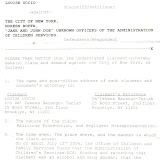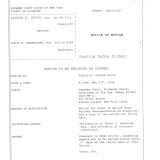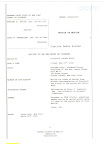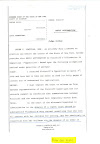UPDATE From -
Disgusted with the system: Mother watches over Alta. boy badly hurt in foster care
By Renata D’Aliesio, Canwest News Service
CALGARY — Nearly all of them are faceless and nameless.
They are the 51 Alberta children who have died in the province’s care over the past decade, some at the hands of government-approved caregivers.
Their deaths happened in all sorts of manners: in freak car crashes and suicides, in accidental falls and at the hands of violent shaking.
Most of these children, though, have one thing in common. Two-thirds of them were native.
Indeed, this is true of the three youngsters killed in foster care since 2005.
Today, another aboriginal foster child is struggling with severe brain damage in a Calgary hospital. Mounties are investigating how the 15-month-old was so badly injured and whether his perilous state is the result of an accident or a criminal act.
Alberta laws governing children in care, prevent the publishing of his name or the names of other children who’ve died in government care.
The toddler’s 21-year-old mother, a member of the Calgary-area Tsuu T’ina First Nation says she’s frustrated with the whole child-welfare system.
She said she wishes her son and daughter had been placed in a home on the reserve, but was told no aboriginal family was available to take the pair.
“Their excuse is that there wasn’t enough foster parents on the reserve,” said the young mother, who also can’t be identified under provincial laws. “Even so, they should have put him with a native family in the city.”
As she and the public wait for the outcome of the police probe, the reality is several more aboriginal children have been placed in Alberta government care since the boy’s injuries were reported March 2.
Of the 5,970 children currently in foster or kinship care, 3,760, or 63 per cent, are native — drastically disproportionate to their four per cent share of Alberta’s population.
The rate of serious injury and death in government care, at 0.1 per cent, is lower than in the general population, the province’s figures show. However the sheer volume of native youngsters in child welfare, most of them from First Nations communities, underscore the complex social problems that cross decades and generations.
Funding inequities are also at play, the federal auditor general reported last May.
In its first examination of child and family services on First Nations, the auditor general found Ottawa’s two-decades-old funding model was broken.
Federal dollars have been based on an assumption that six per cent of on-reserve children require government care, when in reality the figure ranged as high as 28 per cent in 2007.
Moreover, these dollars kicked in when children were taken from their families, while few funds were put toward prevention efforts.
As a result of the “outdated” formula, the auditor general said, some aboriginal children and families didn’t get the services they needed.
Inadequate funding also hampered the communities’ ability to attract and retain child-welfare workers, who can generally make more money doing the same job off-reserve.
“The use of this funding formula has led to inequities,” said Jerome Berthelette, who was on the federal audit team.
The auditor general concluded the federal department can’t properly answer a fundamental question: Are aboriginal children in government care better off?
Indian and Northern Affairs Canada accepted all of the auditor general’s recommendations.
The year before, it already began moving toward a new funding model, signing an agreement with the Alberta government and the province’s First Nations in June 2007.
The five-year, $98-million pledge will boost funding for child-welfare operations and prevention programs by 74 per cent. Ottawa hopes to ink similar deals with the other provinces and territories by 2012.
“It’s more of a prevention-focused approach,” said Indian and Northern Affairs spokeswoman Patricia Valladao.
Reaction to the federal change has been largely positive.
Provincial minister Gene Zwozdesky, who oversees aboriginal relations, said the new model will better help families struggling to care for their children.
Zwozdesky said the shift toward early intervention should lead to fewer aboriginal youngsters in government care.
“Another initiative coming out of these funds will be more mentorship programs and also those that deal with social-related issues, like suicide prevention, family-violence prevention,” he added.
Chief Morris Monias of Heart Lake First Nation, northeast of Lac La Biche, believes the extra dollars will help alleviate some of the frustration felt by child-welfare workers in his community.
“A lot of the programs we wanted to fund we just couldn’t afford in the past, so a lot of children fall through the gaps,” Monias said.
Meanwhile, the assembly and the First Nations Child and Family Caring Society of Canada have filed a joint human rights complaint, accusing the federal government of racially discriminating against aboriginal children by underfunding them. A tribunal has been ordered.
“The critical area of underfunding is services to keep children safely in their homes,” said Cindy Blackstock, executive director of First Nations child society.
“That drives unbelievable removal rates. We have three times the number of First Nations kids in child welfare care today than we did at the height of residential schools.”
Recently, the province has made a greater effort to place native foster children with relatives in a program called kinship care, which has seen the number of placements grow 97 per cent in the past three years.
The Alberta government has also launched an aggressive drive to recruit foster parents, particularly from aboriginal communities. The number of foster parents overall has decreased 15 per cent since 2005.
Still, the latest Children and Youth Services annual report shows that only 38.5 per cent of native children in foster and kinship care are being placed with native families.
Siksika Nation Chief Leroy Good Eagle, who himself was a foster child, said it’s crucial to ensure aboriginal foster children don’t lose ties to their culture.
Unlike foster care homes, kinship placements are not licensed and there are no limits on the number of youngsters, although provincial figures show only seven of the 780 kinship homes have more than four foster children. (Five per cent of Alberta’s 2,300 foster homes have more than four children.)
Kinship caregivers must complete the same initial training as foster parents and are subject to a home assessment, a criminal record check and a child welfare intervention history.
Of the three youngsters killed in foster care since 2005, two were in the kinship program and the third was under the care of a registered nurse.
In January, a four-year-old Metis girl died of head injuries in Edmonton.
Her 24-year-old aunt, who was also looking after the girl’s five siblings, has been charged with murder, criminal negligence causing death, and failing to provide the necessities of life.
Neither the RCMP or Alberta Children and Youth Services will disclose any information about the foster parents who were caring for the 15-month-old boy in Calgary hospital.
The toddler was moved out of the intensive care unit last week, his grandmother said Saturday.
A team of brain injury experts at the Children’s Hospital is working with him. Doctors have told the family the toddler has severe cerebral palsy and will have to stay in the hospital for months.
But at least he’s finally awake and breathing on his own.
“He’s yawning, he’s moving a bit,” his grandmother said. “It’s still a long road ahead.”
Calgary Herald
With files from Jamie Komarnicki and Jason Fekete, Calgary Herald
© Copyright (c) The Calgary Herald
Alta. foster-care tragedies dominated by native children
Copyright Notice: According to US Copyright law, copyright vests initially in the author(s) of the work. In accordance with Title 17 U.S.C. section 107, any copyrighted material herein is distributed without profit or payment to those who have an interest in receiving this information for non-profit research and educational purposes only. For more information go to: Title 17, Sec.107. If you are the copyright holder and choose to have your work removed from this website, email HaveUmistakenMe@aol.com and it will be done. However, we hope you prefer that our researchers continue to benefit from access to your work.
Subscribe to:
Post Comments (Atom)























No comments:
Post a Comment